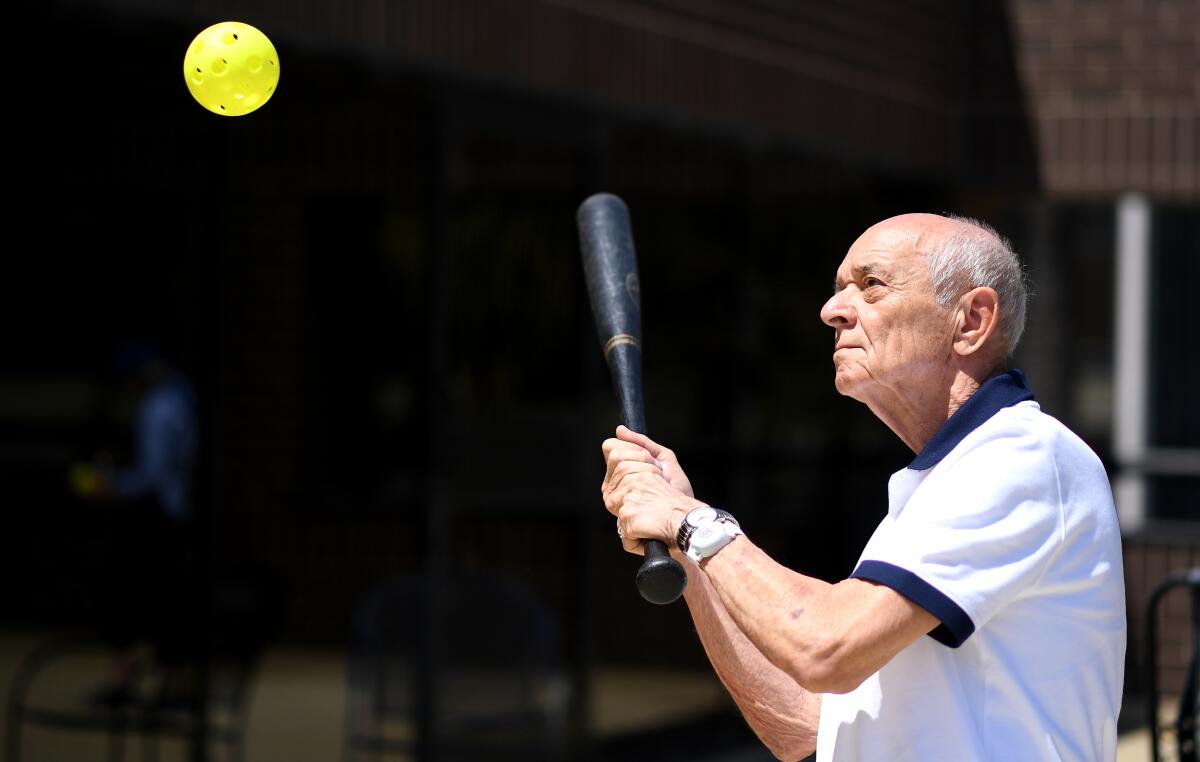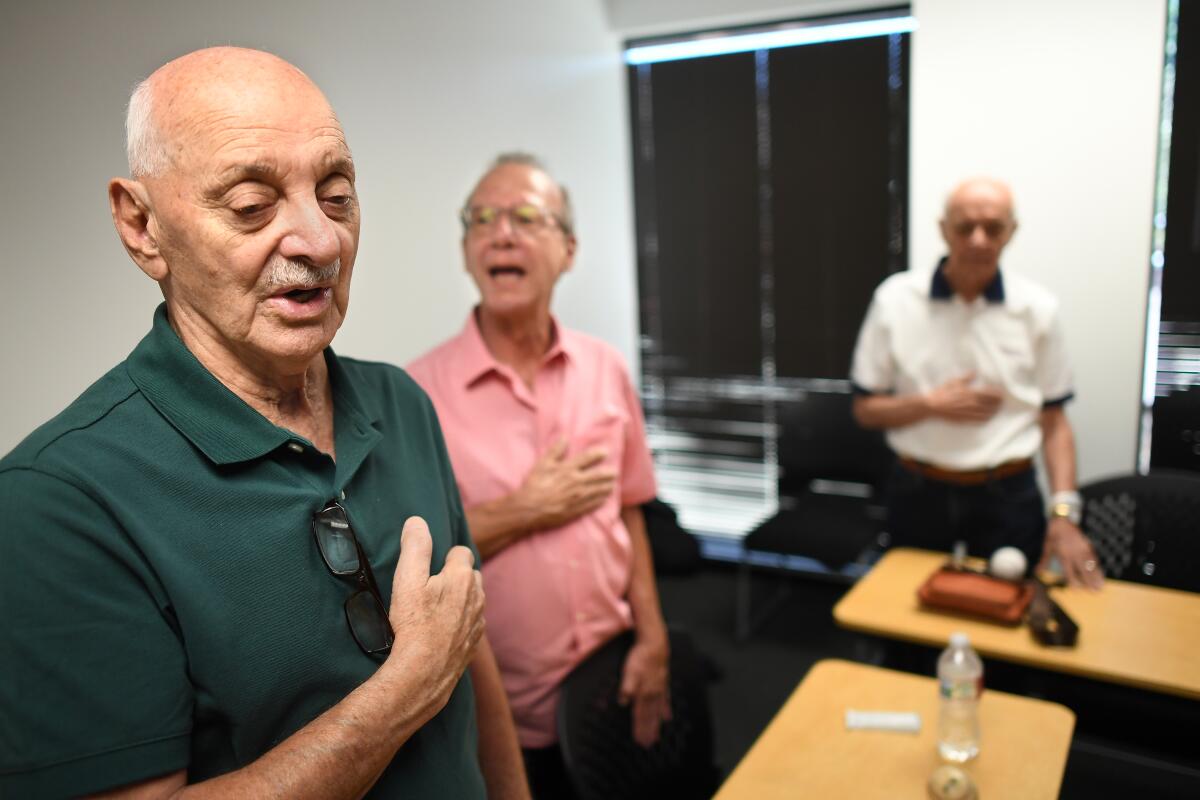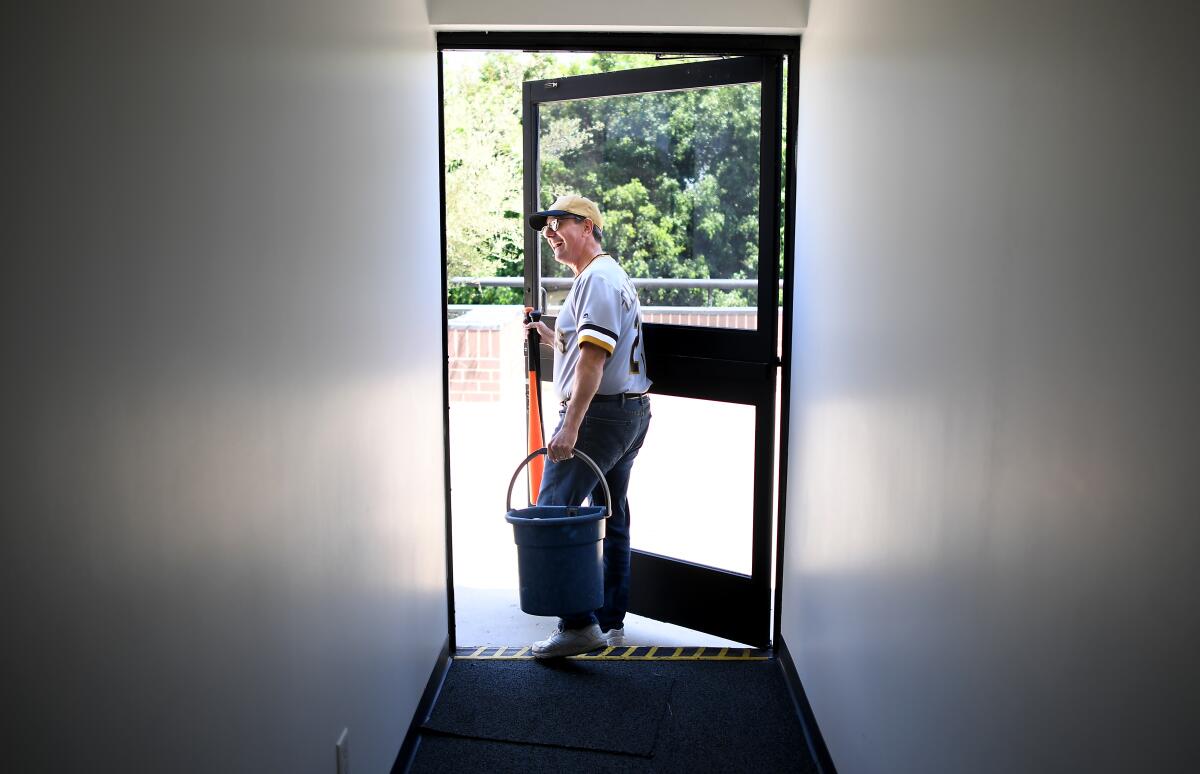Column: Fighting the ravages of Alzheimer’s and dementia with the beauty of baseball

- Share via
It starts with a baseball.
Each person who attends the monthly BasebALZ program in a conference room at the offices of Alzheimer’s Los Angeles is handed one, faded and scuffed.
For the next two hours, those suffering from Alzheimer’s disease or other forms of dementia will hold that baseball.
Some will clutch it tightly as they listen to stories about former baseball greats. Others will roll it around in their palms as they watch presentations about baseball’s historic moments. At some point, they will be asked to reach back into their own baseball history.
Through the magic of those 108 stitches, they will remember.
“My friends and I lived near each other, we’d play together,” Al Hassan, 82, says with a grin. “I wasn’t very good, I played way out in the field. There was a little creek they put me near in case I had to jump in the water. It happened three or four times. I think they were agitating me!”
It’s a bright Friday morning, and Hassan laughs, and across the table, Dolores Jones, 89, soon joins him.
“There was this St. Louis pitcher, I would stay up late to watch him on TV,” she says with a grin. “He put his cap low; it was scary for hitters. They’re looking for his eyes, they’d let a pitch go by.”
Jon Leonoudakis, the meeting facilitator dressed in a gold vintage Pittsburgh Pirates jersey and cap, jumps in.
“Oh, you’re talking about Bob Gibson,” he says, pausing, then raising his voice in wonder. “And did you know he wore glasses?”
The room instantly buzzes with oohs and aahs and lights in eyes that have been growing dim. Baseball has done it again. Baseball has wrapped its arms around unsettled souls and taken them out to the ballgame.

“Watching what happens here is like watching people come to life,” says Anne Oh, manager of support groups and activity programs for ALZLA.
Even in a summer when the major leagues’ best team plays at Dodger Stadium and its best player plays at Angel Stadium, nowhere is the power of baseball in Los Angeles better illustrated than on the fourth floor of this mid-Wilshire office building.
Led by members of the Los Angeles chapter of the Society for American Baseball Research, a group of as many seven dementia patients and their companion caregivers participates in what is known as baseball reminiscence therapy.
In sessions designed to elicit moments of clarity through a century-old connection with the national pastime, participants talk ball, sing ball, and even play a little ball.
According to their caretakers, it is the first time some of them have engaged in weeks. From talk of Little League to thoughts of autograph chases, delving deep into poignant childhood memories, there is something about the ancient sport that rustles the mind.
“Watching what happens here is like watching people come to life.”
— Anne Oh
”Baseball is a game of storytelling; it’s the heart and soul of the sport. Everyone has baseball stories, everyone has baseball memories,” says Leonoudakis, 61, a producer who brought the program here after hearing about its success in the Central/South Texas SABR chapter. “These people grew up during the game’s golden age, so it seems like such a natural fit.”
Oh, whose office also hosts therapeutic programs involving art, music, gardening and dance, says baseball touches a nerve.
“It brings them to the present,” she says. “Individuals with dementia are often just home and not engaging in conversation, not being stimulated with activities. When they come here, it stirs up strong memories they have not thought about for a long time. It opens them up. It’s real and important socialization.”
It starts with a baseball, but officially begins with a song. On this Friday, after Leonoudakis passes out baseballs from a plastic grocery bag — they’re remnants from his youth league coaching days — he pulls out a guitar and everyone stands up.
Because of the usual last-minute cancellations, and because the innovative program has been around only a year and still is gaining traction, there are only three participants today. But, along with their caregivers, they sing the national anthem like they are a group of 30,000.

“Play ball!” Leonoudakis finally shouts, marking the beginning of what is essentially an admission-free day at an imaginary ballpark.
There are concessions, with free pecan cookies, water and coffee. There are bobblehead dolls, with Leonoudakis passing around tiny sculptures of the generation-spanning Clayton Kershaw, Randy Johnson and Tom Seaver.
Then there are stories, plenty of stories, with this week’s tales focused on legendary Negro Leagues pitcher Chet Brewer and that wonderful Pasadena historical institution known as The Baseball Reliquary.
But the best tales come from the participants themselves, spurred by a Leonoudakis question.
“When you hold that baseball in your hands, what does your heart and soul say?” he asks.
Hassan says, “Watch me, I throw pretty good.”
Jones says, “I haven’t been to a baseball game in a long time. I wanted to come here to see what it was like.”
Then Richard Machinski, 78, speaks for the first time.
“It’s what we did when I was 8 years old,” he says. “It keeps you alive.”
Machinski is handed a photo by his wife Eva. It was from when he coached a youth league team in Bremerton, Wash., in the early ‘70s.
“It’s what we did when I was 8 years old. It keeps you alive.”
— Richard Machinski on baseball
There are two girls on the boys’ team, an odd sight for that era, and Machinski suddenly remembers why.
“I said, ‘If they don’t play, we don’t play,’” he says.
As his health declined, Machinski has increasingly clung to his moments with this group. He constantly asks Eva about the date of the next session. One of his drawings from an art therapy session illustrated this longing.
Amid bright colors he wrote, “I draw pictures, I give them to my wife because I love her, it’s now baseball time.”
Machinski even recently brought in flour sacks that were used as baseball jerseys by his naval team.
“I played pitcher and catcher,” he says, and when he is asked if it was fun, he exclaims, “100%!”
After the presentation and discussion ends, there is a seventh-inning stretch. Of course there is. Everyone stands and Leonoudakis picks up the guitar and plays “Take Me Out To The Ballgame.”
Afterward he shouts, with the excitement of a kid hollering at his neighborhood buddies, “Let’s go play some ball!”
The group then moves to a patio where Leonoudakis pitches giant yellow and white Wiffle Balls to participants wielding a black Wiffle bat.

It is the first time some of them have swung a bat in more than 50 years. Some struggle with their coordination. They step into the box tentatively, and hold the bat carefully. But once they start, man, can they hit. Everybody makes contact, driving the ball off a brick wall, into a giant plant, rattling shots around the metal furniture and even off a patio umbrella.
The companions also take their hacks, and Eva Machinski swings out of her shoes. The program is designed not only to momentarily lift the cloud from those with Alzheimer’s disease, but also offer a brief respite for those who care for them.
“That swing is for how hard it is to do this, to be a caretaker and companion, to live this every day. This gets the stress out,” she says, clenching her teeth before regaining her smile. “We both need this.”
The last participant to come to the imaginary plate is Jones. She doesn’t want to do it, but her daughter Freda urges her, and so she steps up for her first at-bat in nearly a century.
And she crushes it. She lines a ball directly off Leonoudakis’ leg as witnesses howl in delight, and for a moment, everyone is present, everything is clear, and Jones beams at this walk-off hit into a warm and familiar sunset.
“I felt like I was reaching for it, and I couldn’t find it,” she says of the pitch. “But I found it.”
For more information on BasebALZ, contact Alzheimer’s Los Angeles at alzla.org or 844-435-7259
More to Read
Go beyond the scoreboard
Get the latest on L.A.'s teams in the daily Sports Report newsletter.
You may occasionally receive promotional content from the Los Angeles Times.











